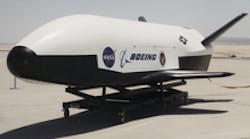| U. S. Air Force, www.usaf.com |
The U. S. Air Force launched the X-37 Pathfinder, an unmanned spaceplane, into orbit atop an Atlas V rocket in April. But what it will do during its estimated three-month space mission remains a closely kept military secret. In fact, it’s still not clear why the Air Force resurrected an experimental NASA vehicle four years after that government agency abandoned it because of funding uncertainties and a reshuffling of NASA’s priorities.
There’s some conjecture that the Air Force is using the X-37 to develop space-based UAVs capable of firing weapons at satellites or sites on Earth. And some believe the X-37 will test cameras and new tracking capabilities, and possibly serve as a reusable space-based spy platform that can be quickly deployed and recovered. The Air Force, on the other hand, insists it needs the spacecraft to retrieve science experiments and small payloads from space without having to send manned vessels to do the task.
The spacecraft started out back in 1998 as a joint NASA-Boeing project that would serve as a way to flight-test space-travel technologies and bring down the price of space travel. The long-term goal was to cut the cost of putting equipment and spaceships into orbit from $10,000/lb to $1,000/lb. Areas of interest included fuel tanks and propulsion systems, thermal-protection schemes, avionics, and structures. The U.S. Air Force joined shortly thereafter and wanted to test solar arrays and spacecraft attitude controls. In all, 41 different devices and technologies were scheduled to be tested aboard the X-37.
The plan was to build two X-37s. The first, an unpowered version, would test approach and landing performance, as well as turnaround operations. A B-52 would carry it to 40,000 ft and release it on a simulated re-entry trajectory. The follow-on X-37 would determine the craft’s performance in space, as well as during reentry and landing. The vehicle was sized to be carried into orbit by the Space Shuttle, but later studies showed that such Shuttle missions would be uneconomical. So the X-37 was reconfigured to go aloft aboard a Delta or Atlas rocket launcher.
Those plans went awry in the mid-1990s and NASA handed off the program to Darpa, where it became a classified project. Then Darpa passed it on to the Air Force, which runs it today. And after this year, when NASA retires the Space Shuttle, the Pathfinder will be the only U.S. spaceplane.
The 11,000-lb spacecraft measures 27.5-ft long with a wingspan of 15 ft, which is small enough to fill only half the payload bay of a Space Shuttle. Like the shuttle, it is rounded on top and flat on the bottom. And it sports double-delta wings and dual horizontal stabilizers for reentering through the atmosphere and landing. The X-37’s cylindrical payload bay measures 7-ft long and 4 ft in diameter and has two hatches that open, exposing it to outer space. Propulsion comes from a Rocketdyne AR-2/3 rocket engine fueled by hydrogen peroxide and JP-8, a grade of kerosene commonly used as jet fuel. This combination of fuels is less toxic and more compact than most other rocket propellants. The spaceplane can remain in orbits ranging from 125 to 575 miles above Earth for a maximum of 270 days.
The X-37 should land like the Shuttle, coming back into the atmosphere with a 40° nose-up attitude. Once low enough, it will transition to a 20° nose-down glide and fly at up to 220 mph to a landing at Vandenberg Air Force Base in California. Edwards Air Force Base is the alternate.
Copyright 2010, Penton Media Inc. All rights reserved.
